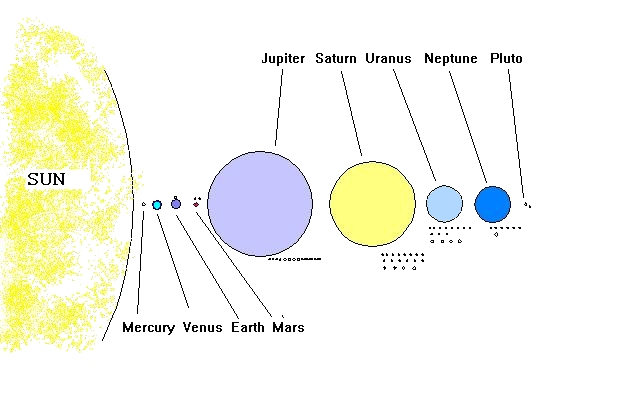The Earth in Space
Our Sun is a STAR.
A star is very hot and gives out its own light. (An object that gives out its own light is called a LUMINOUS object.)
A group of stars is called a GALAXY.
Our sun is part of a galaxy called the MILKY WAY.
The Universe is made up of many such galaxies.
The Earth is a PLANET.
The planets do NOT give out their own light but reflect the light from the sun.
The planets are in ORBIT around the sun.
This means they go around the sun.
Our planet, Earth, is part of the SOLAR SYSTEM. The Solar System contains 9 planets.
A SATELLITE is in orbit around a planet.
The MOON is a kind of natural satellite and is in orbit around the Earth.
Planets and satellites are held in orbit by the pull of the Earth’s gravity.
Most planets have several moons. The Earth has only one moon.
(see diagram of the planets in the solar system)
A moon does not give out its own light but reflects the light from the Sun
The Earth also has several ARTIFICIAL SATELLITES.
These are used to transmit television pictures or radio messages.
Seasons and the length of day and night
The time it takes a planet to go once around the sun is called a YEAR.
The Earth’s year = 365 days.
Most planets SPIN about their own AXIS. The time it takes the planet to spin once on it’s axis is called a DAY.
Seasons
Seasons, and the length of day and night are both caused by the TILT of the Earth.
In Summer the Northern hemisphere is tilted towards the sun. This gives us longer daylight hours. As the sun is overhead for more of the time it causes the ground to heat up more.
In winter the northern hemisphere is tilted AWAY from the sun. This makes the day-light hours less. The sun is lower in the sky and so the ground does not absorb so much of the suns heat.
ECLIPSES
An eclipse of the Sun is caused by the moon being between the sun and the earth and casting its shadow on the Earth, so blocking out some (a partial eclipse) or all (a total eclipse) of the sun’s light.
An eclipse of the moon is caused by the Earth’s shadow falling on the moon, making it invisible from Earth.
Eclipse of the sun (solar eclipse)
Eclipse of the Moon (lunar eclipse)
| In a lunar eclipse (eclipse of the moon), the Earth is between the moon and the Sun and a shadow of the Earth falls across the moon. When the Moon is in the Earth’s shadow the moon cannot be seen. |
 |
The Planets
Planets of the solar system (including moons) drawn with their sizes to scale
 Some planet facts (click to enlarge)
Some planet facts (click to enlarge)

Note: You do not need to know numeric details of the planets for exams like the Common Entrance but you need to be able to answer questions like this:
- How many planets are there?
- Which is the furthest planet from the sun?
- Name the four largest planets?
- .Name the four planets nearest to the sun
- What is meant by the terms: sun, planet, moon, satellite, orbit, day, year, eclipse?
- What causes day and night?
- Which planet was the last to be discovered. Why did it take so long to discover it?
- Describe any step in the history of space exploration that you think important, along with the year it happened .
Some figures
- The temperature at the surface of the sun is about 6000C and at the centre about 14 million C.
- The distance of the Earth to the sun is about 150 million km.
- As astronomical distances are so large they are often given special units: eg
- The AU (=Astronomical Unit=average distance of Earth from the sun)
- The light year (= distance travelled by light in one year 1×1016m 10 million million kilometres).
- The parsec ( just over 3 light years)
- The nearest star to us, Alpha Centauri, is about 4 light years away.
Further research
The Planets: Nasa guide to the Planets
The Solar System : Nasa guide to the Solar System
Powers of Ten – An interesting animation that starts you off at 10 million light years away from the Milky Way and by a succession of pictures zooms you down to a single proton in Florida.
Give it time to load!
Cut out and make a scale solar system!
Double click on the image to load it full size.
It will print out A4 size so may take a few moments to download




